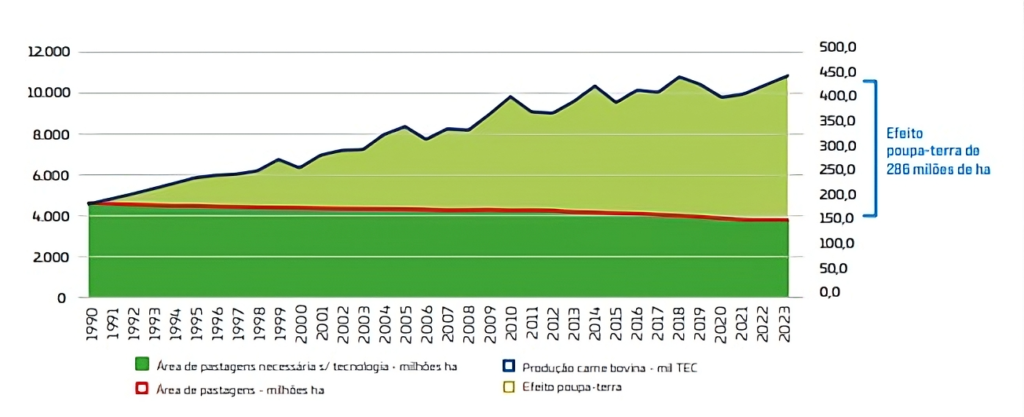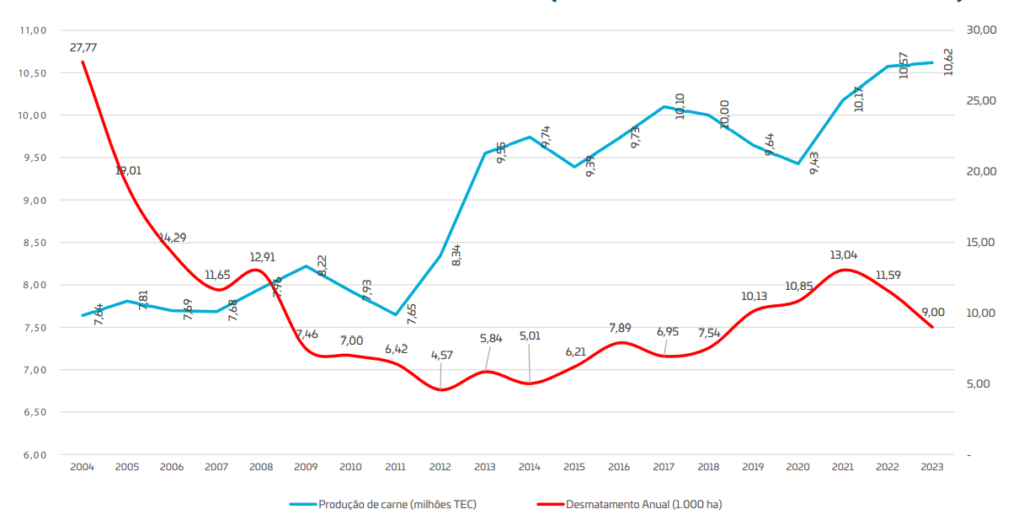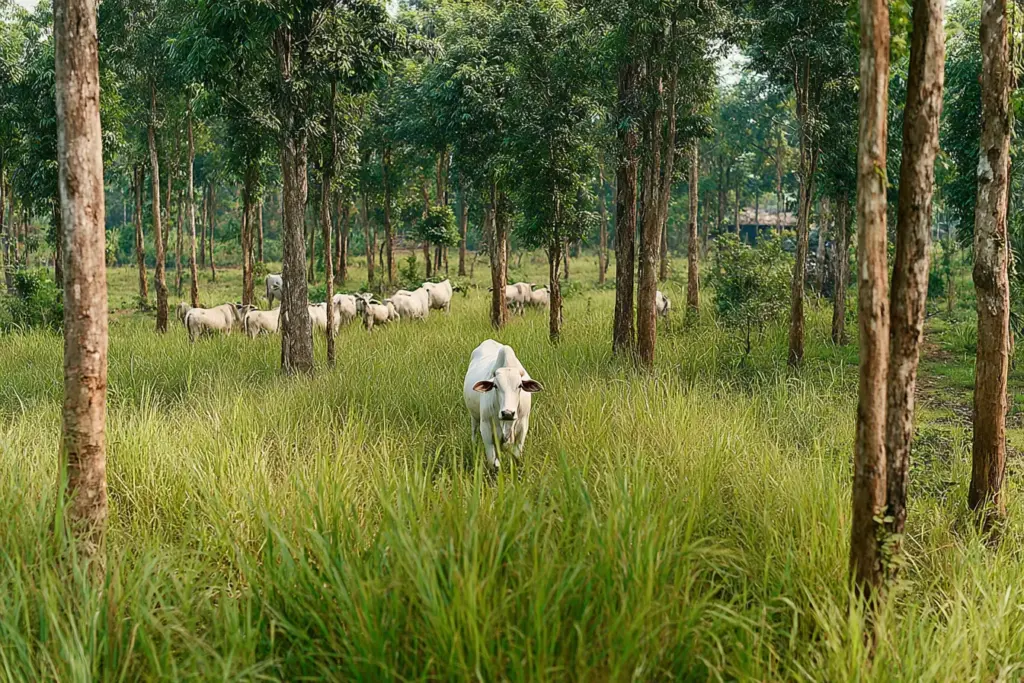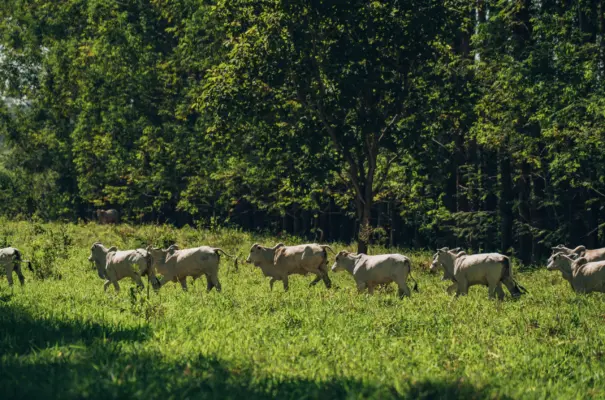If Brazil were currently using cattle ranching technology from three decades ago, an additional 286 million hectares would be needed for the country to reach its current production levels. This area represents approximately 33 times the size of Portugal and about 33.6% of Brazilian territory. This revelation comes from the study “Carne Bem-Criada,” prepared by Adeca Agronegócios, a consulting group from the “Luiz de Queiroz” College of Agriculture at the University of São Paulo (Esalq/USP), based on data from the Brazilian Beef Exporters Association (Abiec). The study also highlights the dissociation between beef production and annual deforestation in Brazil.
As evidenced in the following graph, even with the significant increase in beef production in Brazil since 1990, pasture area has remained stable or even slightly reduced. This was possible thanks to the advancement of technology in the field, which increased livestock productivity without the need to expand the occupied area — a phenomenon known as the “Land-Saving Effect,” demonstrated in the graph by the light green color — that is, the difference between the area that would be necessary without technologies (red line) and the actual occupied area (in dark green).

Source: Athenagro, IBGE data (PPM, PPT, PAM, Census), INPE (Terraclass/Prodes), Lapig, Rally da Pecuária, Embrapa
Evolution of pasture area, occupation and productivity
This other graph (below) also clearly shows the dissociation between the increase in beef production in Brazil and annual deforestation. Between 2004 and 2023, while meat production (blue line) grew from approximately 7.4 million to over 10 million tons in carcass equivalent (TEC), deforestation (red line) fell from 27.77 thousand hectares to 9 thousand hectares. TEC is a unit of measurement used to standardize the production of different types of meat and represents the amount of meat that would be obtained from a standard slaughter, considering the conversion of meat into carcass (without bones and viscera). This demonstrates that it was possible to intensify livestock production without expanding pasture area through deforestation.
The declining deforestation curve, particularly between 2004 and 2012, contrasts with the upward trend in production starting in 2012, underscoring productivity gains in the sector — meaning, more meat is being produced per already converted hectare. This strengthens the role of technologies and sustainable practices in modern cattle ranching.

Source: ABIEC, based on Athenagro, Agroconsult data, Agrosatélite, IBGE, Inpe/Terraclass, Lapig, Prodes, Rally da Pecuária.
Among these, the most prominent in cattle farming are the development of crops adapted to local conditions, the implementation of multiple annual harvests, and the use of practices such as Crop-Livestock-Forest Integration (ILPF), No-Till Farming System (SPD), Biological Nitrogen Fixation (FBN), and precision agriculture, as listed in the article “Land-Saving Effect: is productivity the key to environmental sustainability in Brazilian agribusiness?”, by Insper researchers.
The contribution of research, government programs, and tools, such as PronaSolos and the Agricultural Climate Risk Zoning (Zarc), have also been fundamental for the efficient use of land, as well as genetic improvement, management, and nutrition, which optimize animal performance efficiency, stocking rates, and the use of pasture areas.

Image generated by Artificial Intelligence
Land-Saving Effect, exponential global impact
The use of advanced technologies and practices can still contribute much more to the efficient use of land, enabling the productive increase that the growing global demand for animal protein requires, without converting new areas into pastures. This is because, as evidenced by the USP study, currently 76% of properties dedicated to this activity have productivity below the national average, which is 67.7 kg of carcass/ha/year, according to the 2024 Beef Report from the Brazilian Beef Exporters Association (ABIEC). At Minerva Foods, for example, this index reached 80.72 kg of carcass/ha/year in the same year, due mainly to the export market, which rewards those who produce with sustainable intensification.
The document indicates that if this 76% of farms had access to the same level of technology as highly productive properties, Brazil – alone – could supply approximately 68.61% of the global demand for beef, without needing to expand production areas. Currently, the country is responsible for 13.8% of global production, according to Abiec.
This is one of the objectives of the Renove Program, promoted by Minerva Foods. The project operates on three fronts: green finance, technical partnerships, and training and technical assistance.
While the green finance front focuses on making credit lines and funds available that recognize the performance of ranchers committed to sustainable practices, the technical partnerships front aims to ensure the use of internationally recognized and scientifically backed methodologies and innovations. Finally, through the training and technical assistance front, the company provides support for ranchers to implement low-carbon emission technologies, combining profitability and sustainability. This is achieved through rural extension activities, technology transfer, and training so that rural technicians and ranchers acquire the necessary tools and knowledge to maintain best practices in their operations.
As explained by Minerva Foods’ Executive Sustainability Manager, Gracie Verde Selva, “these measures contribute to paving the way for sustainable and profitable agribusiness, based on best practices in pasture and cattle management, which increases productivity in the same area, ensuring the principle of the Land-Saving Effect.” According to Gracie, “the information from Esalq and Abiec, which are references in data collection and interpretation on livestock, demystifies the association between deforestation and the beef supply chain in Brazil, showing that cattle ranching grows without pressuring forests. It grows by valuing socio-environmental responsibility through technology and efficiency.”
It is this trajectory, based on innovation, sustainable intensification, and good practices, that positions Brazil as a global reference in low-environmental-impact agricultural production. In a scenario where the world turns its eyes to the Amazon with the holding of the 30th United Nations Climate Change Conference (COP30) in Belém/PA, this narrative gains even more relevance. It is time for the country to consolidate its climate leadership, taking advantage of opportunities and its potential to show that it is possible to supply the planet with beef sustainably, increasing productivity without encroaching on new areas — a true breadbasket of the world that grows in efficiency, not in territory.




